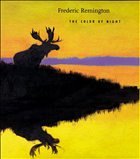In the decade preceding his untimely death, Frederic Remington (1861-1909) produced a series of paintings that took as their subject the color of night. This richly illustrated volume is the first to present all of these works--some seventy paintings that secured for Remington the critical acclaim he so coveted. Indeed, these magnificent nocturnes marked an important new direction for the celebrated illustrator, writer, and sculptor of America's vanishing frontier.
In these deeply personal works, Remington explored the technical and aesthetic difficulties of painting darkness. Surprisingly, his images are filled with color and light--moonlight, firelight, candlelight. Focused on the subject the artist had made his own--the American West--these paintings reflect Remington's dramatic reworking of the narrative tradition as well as the spare modernism of his late work.
Frederic Remington: The Color of Night, accompanying the first exhibition devoted to the nocturnes, includes three insightful essays discussing Remington's nocturnes within the literary, historic, aesthetic, and technological context of his time. The nocturnes do much more than document a night that was rapidly disappearing under bright, newly installed electric lights. They also reveal how this son of a Civil War hero moved from burnishing Theodore Roosevelt's rough riding heroics in Cuba, to exploring, like Stephen Crane and Ernest Hemingway, his own soul-searing war experience, and, like Joseph Conrad, to probing America's own heart of darkness.
As the definitive resource on Remington's nocturnes, this volume pairs large reproductions of these stunning paintings--including newly conserved works and others not seen publicly since the artist's death--with commentary from his personal diaries and letters and from contemporary critics.
This new and imaginative look at Remington's night pictures secures the artist's place in the history of American art, rather than exclusively in the history of western American art, and promises to attract a large audience from aficionados of the West to those interested in a cultural history of early-twentieth-century America. Remington's works are well known by most museum goers and beloved by a segment of an even wider public. Clearly written throughout, this book will put him literally in a new light for these and new audiences. By connecting Remington's pictorially and psychologically darkest pictures to Whistler's nocturnes; to Crane, Conrad, and Hemingway; and to the new technologies of electric light and flash photography, Anderson, Nemerov, and Sharpe bring Remington into the twentieth century and give him the place he deserves in a modern world.
Carol Clark, Amherst College
In these deeply personal works, Remington explored the technical and aesthetic difficulties of painting darkness. Surprisingly, his images are filled with color and light--moonlight, firelight, candlelight. Focused on the subject the artist had made his own--the American West--these paintings reflect Remington's dramatic reworking of the narrative tradition as well as the spare modernism of his late work.
Frederic Remington: The Color of Night, accompanying the first exhibition devoted to the nocturnes, includes three insightful essays discussing Remington's nocturnes within the literary, historic, aesthetic, and technological context of his time. The nocturnes do much more than document a night that was rapidly disappearing under bright, newly installed electric lights. They also reveal how this son of a Civil War hero moved from burnishing Theodore Roosevelt's rough riding heroics in Cuba, to exploring, like Stephen Crane and Ernest Hemingway, his own soul-searing war experience, and, like Joseph Conrad, to probing America's own heart of darkness.
As the definitive resource on Remington's nocturnes, this volume pairs large reproductions of these stunning paintings--including newly conserved works and others not seen publicly since the artist's death--with commentary from his personal diaries and letters and from contemporary critics.
This new and imaginative look at Remington's night pictures secures the artist's place in the history of American art, rather than exclusively in the history of western American art, and promises to attract a large audience from aficionados of the West to those interested in a cultural history of early-twentieth-century America. Remington's works are well known by most museum goers and beloved by a segment of an even wider public. Clearly written throughout, this book will put him literally in a new light for these and new audiences. By connecting Remington's pictorially and psychologically darkest pictures to Whistler's nocturnes; to Crane, Conrad, and Hemingway; and to the new technologies of electric light and flash photography, Anderson, Nemerov, and Sharpe bring Remington into the twentieth century and give him the place he deserves in a modern world.
Carol Clark, Amherst College

